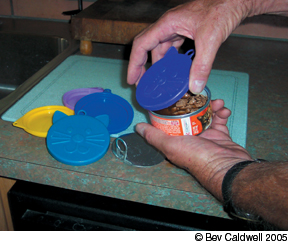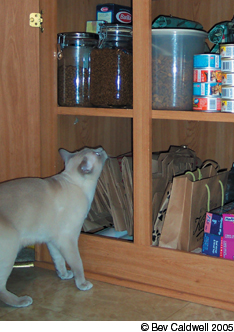The things that can damage your cats food read like an evening weather report – heat, moisture, air and sunlight. Add to that an unhealthy dose of insects or rodents, and you have a recipe for disaster – the food that you spent your hard-earned dollars to buy for your feline companion can become stale, rancid and moldy – in other words, inedible.

288
Storing your cats food safely requires only a few precautions. Its really a matter of common sense, says Francis A. Kallfelz, DVM, PhD, the James Law Professor of Veterinary Nutrition at Cornell Universitys College of Veterinary Medicine. You wouldnt store food for your own consumption improperly. Its the same for your pets food.
Proper food storage depends on the type of food. Most cat food is either dry or canned (wet), and each is adversely affected by environmental conditions to varying degrees.
How to Keep Dry Food Fresh
Once a bag or box of dry food is opened, it is susceptible to the effects of air and moisture. An open bag of dry food or a bowl of freely fed dry food will not succumb to the negative effects of overexposure if left out for brief periods of time. Air is not going to hurt dry food in the short run, says Dr. Kallfelz. You can leave dry food out for a day or two without harm.
Over the course of months, however, leaving bags of dry food open can cause them to become rancid or stale. Long-term exposure to air can contribute to oxidation of fats, says Dr. Kallfelz. Leaving dry food in a properly sealed, previously opened bag or in a closed container for over a week or two wont hurt the food.
If the air is humid, open bags of cat food or old food that is left in bowls and covered over with fresh food can become moldy. Storing dry food in basements, bathrooms or other moisture-prone areas of your home can cause it to develop mold, rendering it inedible. Depending on where the open bag of food is stored, it can become laden with insects or rodents that may chew through the bag or deposit feces in the food as they consume it. Store food in closed containers, advises Dr. Kallfelz.
Sunlight can destroy vitamins that are sensitive to light, so keep food out of direct sunlight. Air in the presence of heat and light will cause many nutrients to break down more quickly, says Dr. Kallfelz.

234
Keep cat food in a cool, dry environment so it does not overheat or become damp.
Increased heat can increase rancidity, says Dr. Kallfelz. If the food gets wet, get rid of it.
Many people buy dry food in large bags to save money. If you have more dry food than your cat can eat in a week or two, place the rest in a sealed container. It doesnt matter if the container is metal, plastic, glass or even a galvanized trash can, as long as its clean and dry, says Dr. Kallfelz.
Food can be stored in the bag inside the container or emptied into it. To keep food at the bottom of the container from going bad, wash the container periodically. Thats just good housekeeping practice, says Dr. Kallfelz.
If you need to move the container around, check out the plastic food containers with wheels that are available in pet stores. Or, if you have room, store excess dry food in the freezer. Dont store food past the expiration date, says Dr. Kallfelz.
If you use a self-feeder for your cats, store only as much as your cat can eat in a short time, especially if the feeder is in a place where insects or rodents could get too it. Self-feeders are okay if used only for a few days, says Dr. Kallfelz.
Canned Food Safety
Unopened canned food lasts longer than dry, but once opened, canned food has a shorter shelf-life than dry food. Canned food will dry out in several hours, says Dr. Kallfelz. If your cat does not eat all of the canned food served, discard the remnants within an hour or so, especially if the weather is warm or humid. If your cat eats only part of a can at one feeding, cover the can with the unused portion in it and store it in the refrigerator. As long as it doesnt dry out and get moldy, it can be kept for a few days in the refrigerator, says Dr. Kallfelz.
If your cats food attracts ants, place the bowl in a larger saucer of water. Ants dont swim and will not cross the water to get to the food. As an alternative, purchase a bowl with a molded lip to hold water. Such bowls are available at pet stores.



